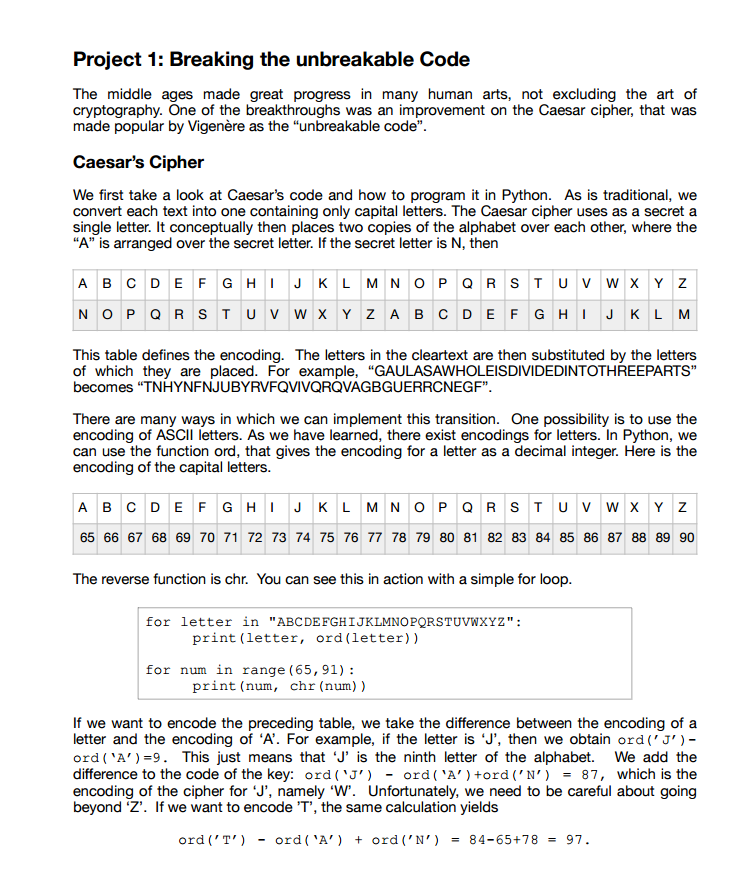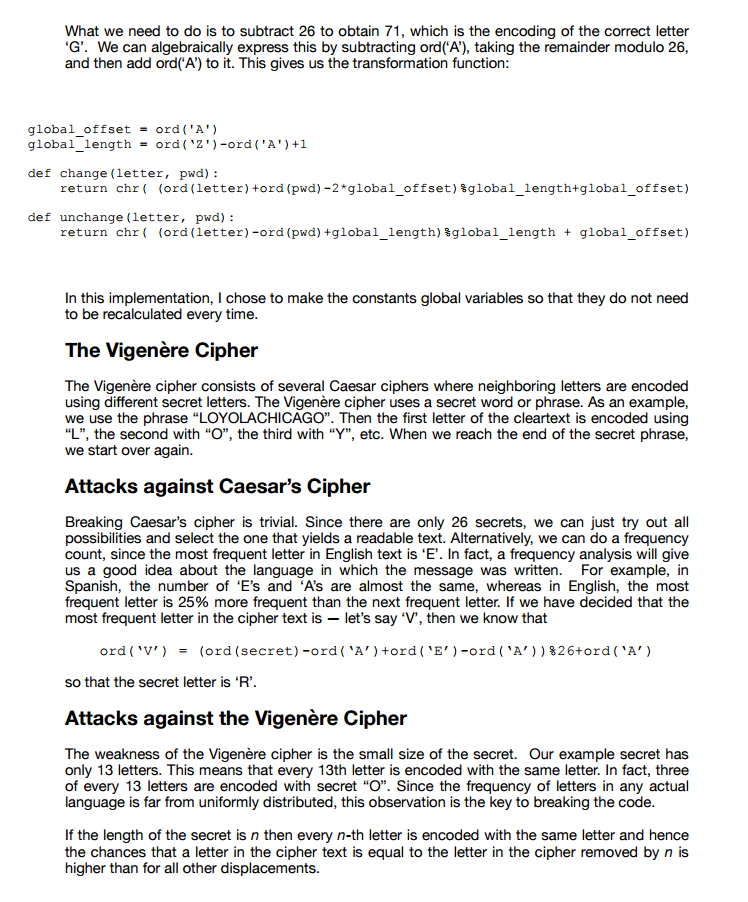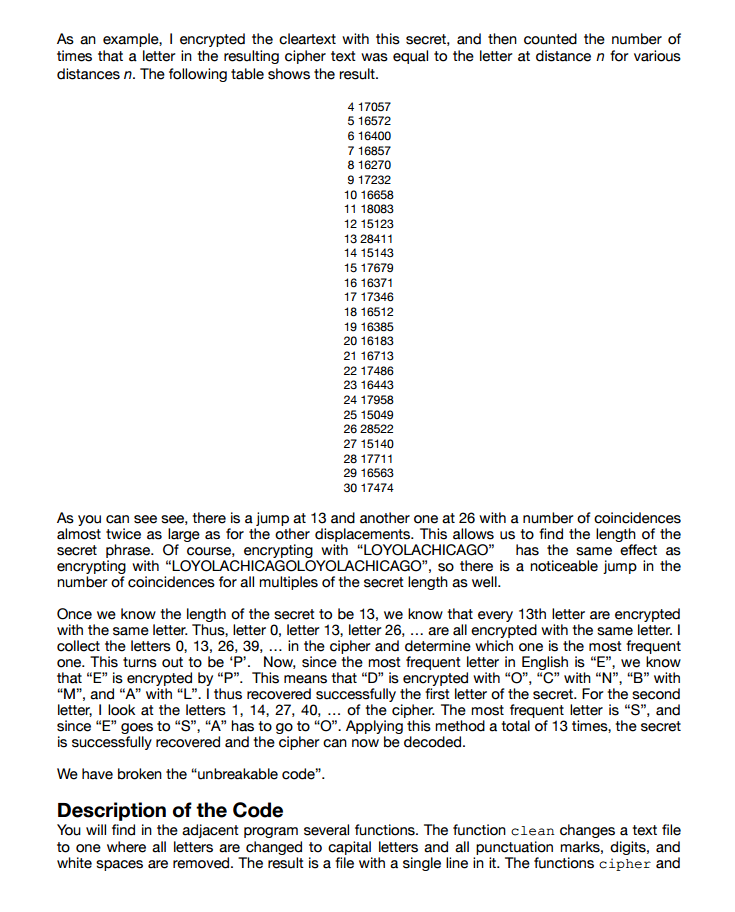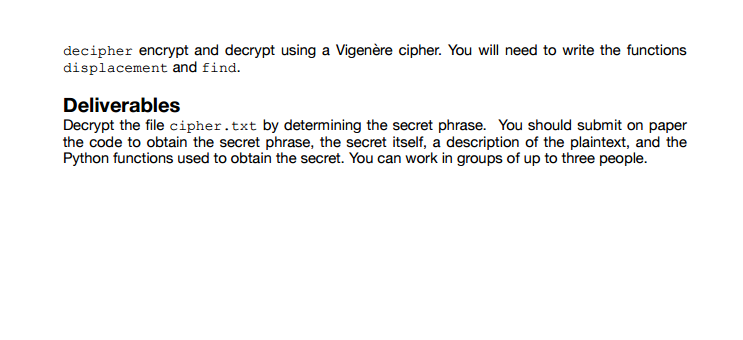Answered step by step
Verified Expert Solution
Question
1 Approved Answer
http://tschwarz.mscs.mu.edu/Classes/COSC1010/Projects/Project1/cipher.txt this is the link for the encrypted file cipher.txt http://tschwarz.mscs.mu.edu/Classes/COSC1010/Projects/Project1/cipher.txt.zip this is the link for the encrypted file cipher.txt as zip file and this




http://tschwarz.mscs.mu.edu/Classes/COSC1010/Projects/Project1/cipher.txt
this is the link for the encrypted file cipher.txt
http://tschwarz.mscs.mu.edu/Classes/COSC1010/Projects/Project1/cipher.txt.zip
this is the link for the encrypted file cipher.txt as zip file
and this is for python thank you very much
Project 1: Breaking the unbreakable Code The middle ages made great progress in many human arts, not excluding the art of cryptography. One of the breakthroughs was an improvement on the Caesar cipher, that was made popular by Vigenre as the "unbreakable code". Caesar's Cipher We first take a look at Caesar's code and how to program it in Python. As is traditional, we convert each text into one containing only capital letters. The Caesar cipher uses as a secret a single letter. It conceptually then places two copies of the alphabet over each other, where the "A" is arranged over the secret letter. If the secret letter is N, then A B C DEF GHIJ K LMNOPQ RST UV WX Y Z NOPQRSTUVVV X Y Z A B C D E F G H I J K L M This table defines the encoding. The letters in the cleartext are then substituted by the letters of which they are placed. For example, "GAULASAWHOLEISDIVIDEDINTOTHREEPARTS becomes "TNHYNFNJUBYRVFQVIVQRQVAGBGUERRCNEGF" There are many ways in which we can implement this transition. One possibility is to use the encoding of ASCII letters. As we have learned, there exist encodings for letters. In Python, we can use the function ord, that gives the encoding for a letter as a decimal integer. Here is the encoding of the capital letters. A B C DEF GHIJ K LMNOPQ RST UV WX Y Z 65 66 67 68 69 70 71 72 73 74 75 76 77 78 79 80 81 82 83 84 85 86 87 88 89 90 The reverse function is chr. You can see this in action with a simple for loop for letter in "ABCDEFGHIJKLMNOPQRSTUVWXYZ": print (letter, ord(letter)) for num in range (65,91): print (num, chr (num) ) If we want to encode the preceding table, we take the difference between the encoding of a letter and the encoding of 'A'. For example, if the letter is 'J', then we obtain ord (' J')- ord ( 'A')-9. This Just means that J, is the ninth letter of the alphabet. We add the difference to the code of the key: ord 'J- ord 'A') tord('N') - 87, which is the encoding of the cipher for 'J', namely 'W". Unfortunately, we need to be careful about going beyond Z'. If we want to encode 'T', the same calculation yields ord ('T') - ord'A ord('N) 84-65+78-97. Project 1: Breaking the unbreakable Code The middle ages made great progress in many human arts, not excluding the art of cryptography. One of the breakthroughs was an improvement on the Caesar cipher, that was made popular by Vigenre as the "unbreakable code". Caesar's Cipher We first take a look at Caesar's code and how to program it in Python. As is traditional, we convert each text into one containing only capital letters. The Caesar cipher uses as a secret a single letter. It conceptually then places two copies of the alphabet over each other, where the "A" is arranged over the secret letter. If the secret letter is N, then A B C DEF GHIJ K LMNOPQ RST UV WX Y Z NOPQRSTUVVV X Y Z A B C D E F G H I J K L M This table defines the encoding. The letters in the cleartext are then substituted by the letters of which they are placed. For example, "GAULASAWHOLEISDIVIDEDINTOTHREEPARTS becomes "TNHYNFNJUBYRVFQVIVQRQVAGBGUERRCNEGF" There are many ways in which we can implement this transition. One possibility is to use the encoding of ASCII letters. As we have learned, there exist encodings for letters. In Python, we can use the function ord, that gives the encoding for a letter as a decimal integer. Here is the encoding of the capital letters. A B C DEF GHIJ K LMNOPQ RST UV WX Y Z 65 66 67 68 69 70 71 72 73 74 75 76 77 78 79 80 81 82 83 84 85 86 87 88 89 90 The reverse function is chr. You can see this in action with a simple for loop for letter in "ABCDEFGHIJKLMNOPQRSTUVWXYZ": print (letter, ord(letter)) for num in range (65,91): print (num, chr (num) ) If we want to encode the preceding table, we take the difference between the encoding of a letter and the encoding of 'A'. For example, if the letter is 'J', then we obtain ord (' J')- ord ( 'A')-9. This Just means that J, is the ninth letter of the alphabet. We add the difference to the code of the key: ord 'J- ord 'A') tord('N') - 87, which is the encoding of the cipher for 'J', namely 'W". Unfortunately, we need to be careful about going beyond Z'. If we want to encode 'T', the same calculation yields ord ('T') - ord'A ord('N) 84-65+78-97Step by Step Solution
There are 3 Steps involved in it
Step: 1

Get Instant Access to Expert-Tailored Solutions
See step-by-step solutions with expert insights and AI powered tools for academic success
Step: 2

Step: 3

Ace Your Homework with AI
Get the answers you need in no time with our AI-driven, step-by-step assistance
Get Started


